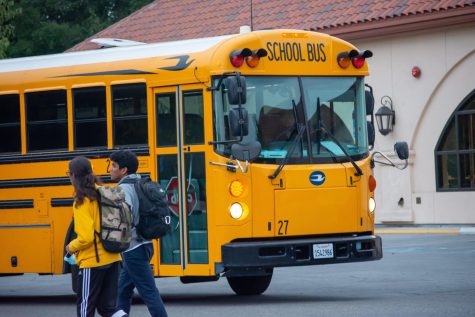District to add long-delayed electric school buses
February 27, 2023
In an effort to go greener and reduce carbon emissions, the Palo Alto Unified School District will add two new electric school buses after spring break.

According to Chief Business Officer Carolyn Chow, the two electric school buses were purchased as a result of funding from the state’s Carl Moyer Grant Program, which helps provide funding for cleaner engines and equipment. The district applied and received the grant two years ago, but as a result of supply chain issues, the buses were delayed.
The two new electric buses will replace the district’s two oldest diesel buses, and Chow said the district will be taking those old buses out of circulation and disposing them.
“With the grant we have the incentive to go greener and cleaner,” Chow said. “The swap is to pull our older buses that have higher emissions and take them off the road and replace them with cleaner buses.”
To determine whether more electric school buses should be purchased in the future, school board president Jennifer DiBrienza said these buses will need to be tested before being used long-term.
“We’d put them into rotation wherever they are needed and as we come to better understand the advantages of electric buses,” DiBrienza said. “We’ll better know both what we can use them for and whether we want to expand the electric bus fleet.”
The grant presents an important opportunity in trying out electric buses that Chow said will pave the way for future district investments in green transportation.
“The grant program gave us the opportunity to pilot two buses and see how those buses perform,” Chow said. “So obviously, the grant was a huge impetus for us to be able to go forward because the electric buses cost about two and a half times what a diesel bus costs.”
Although the district will not replace all the current diesel buses with electric ones, if buses need to be replaced in the future, Chow said electric buses will most likely be used.
“I do not see us saying ‘oh, these two buses are great, we’re just going to get rid of all of our other 20 buses’ and buy all-electric,” Chow said. “I don’t see us doing that because that’s just not a good decision right now just due to the buses being in good shape, [and] we have great mechanics in the district that service them. I think on the replacement level, that [electric buses] would be our direction. So, rather than replace an aging diesel bus with a new diesel bus, replace it with an electric bus.”
Depending on the success of these two new buses, Chow said other district vehicles could also be switched out for electric ones.
“We also looked into doing some of our white fleet, which is what all the maintenance guys use and our landscapers, so maybe look at electrifying some of the white fleet in addition to the buses,” Chow said. “So, we’re taking that into account as well.”



